INSECTS
25 Largest Spiders On The Planet
Published
11 months agoon

Shutterstock
Within the complex and vibrant mosaic of nature, spiders emerge as a group rich in diversity and intrigue. Often eliciting fear and misunderstanding, these arachnids play a vital role in sustaining ecological equilibrium across a myriad of environments. Spanning from the lush canopies of tropical forests, through the shadowy recesses of caverns, to the broad expanses of deserts, spiders demonstrate a remarkable spectrum of sizes, behaviors, and appearances. This introduction to some of the planet’s largest spiders aims to illuminate their distinct traits, ecological significance, and the wonder of their existence. As we delve into the domain of these extraordinary beings, we encourage readers to discover the variety, intricacy, and elegance spiders bring to our world, highlighting the profound biodiversity that enriches our planet.
Goliath Birdeater
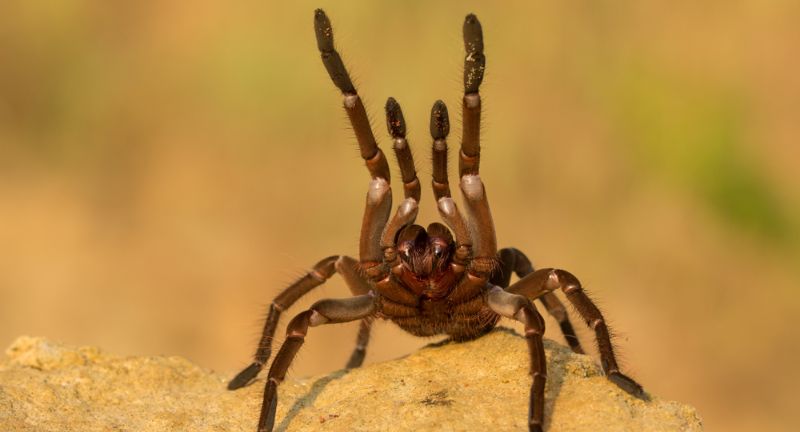
Shutterstock
The Goliath Birdeater stands as the world’s most massive spider. Found in the lush rainforests of South America, it boasts a leg span that is nothing short of impressive. Tipping the scales at over 6 ounces, this spider is a giant in the arachnid realm. Contrary to what its name might suggest, it seldom hunts birds, instead preferring a diet of insects and small mammals.
Camel Spider
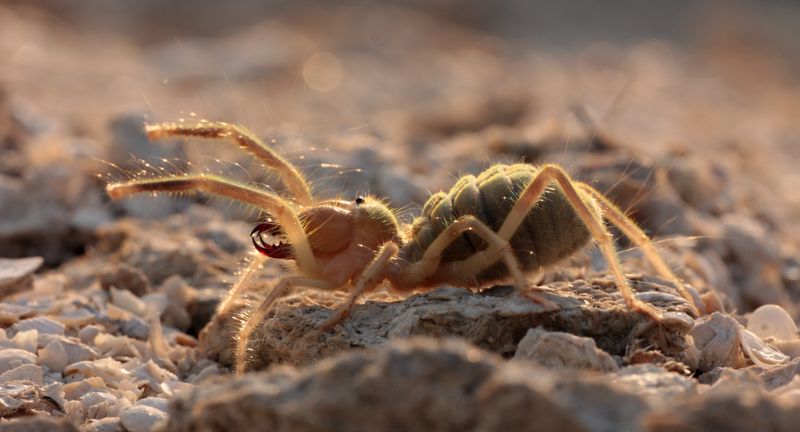
Shutterstock
Camel Spiders, while not genuine spiders, frequently feature in conversations about sizable arachnids because of their notable dimensions, with some reaching lengths of up to 6 inches. These beings inhabit desert terrains and are renowned for their swift movements and formidable looks. Lacking venom, they possess sizable jaws capable of inflicting a painful bite. Camel Spiders are active at night, mainly preying on a diet of ground-dwelling insects and small creatures.
Brazilian Giant Tawny Red Tarantula
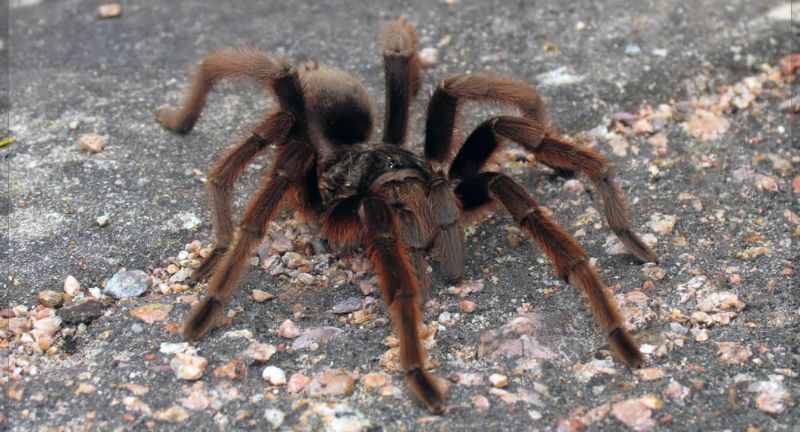
RAP
The Brazilian Giant Tawny Red Tarantula, an imposing figure in the arachnid world, can boast a leg span of close to 10 inches. Native to the forests of Uruguay and Brazil, this tarantula is celebrated for its significant size and the rich tawny-red color of its hairs. As a burrowing species, it excavates deep shelters for dwelling and for staging ambushes on its prey. While its appearance may be intimidating, it poses little threat to humans; its bite, although painful, lacks medical severity.
Colombian Giant Tarantula
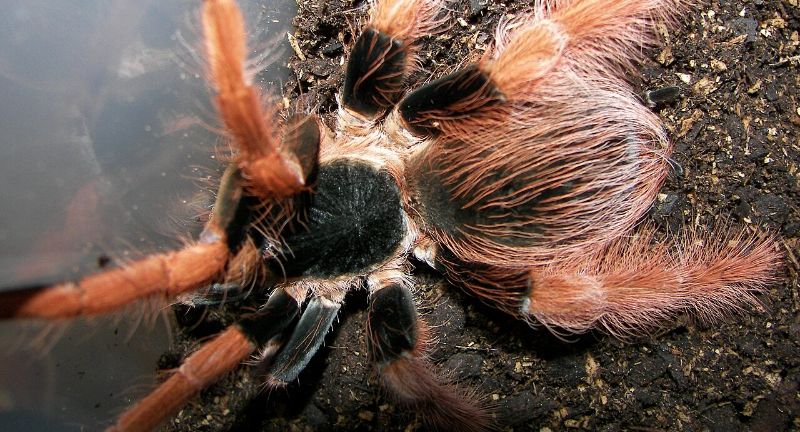
Wikipedia
The Colombian Giant Tarantula, with a leg span extending to 8 inches, captivates with its vivid coloration. Originating from Colombia, this species has garnered admiration among tarantula enthusiasts for its striking beauty. It exhibits a preference for burrowing, opting to ambush prey from the safety of its burrow rather than engaging in active pursuit. Despite its formidable appearance, it represents minimal danger to humans, showing a tendency to retreat rather than confront when faced with a threat.
Singapore Blue
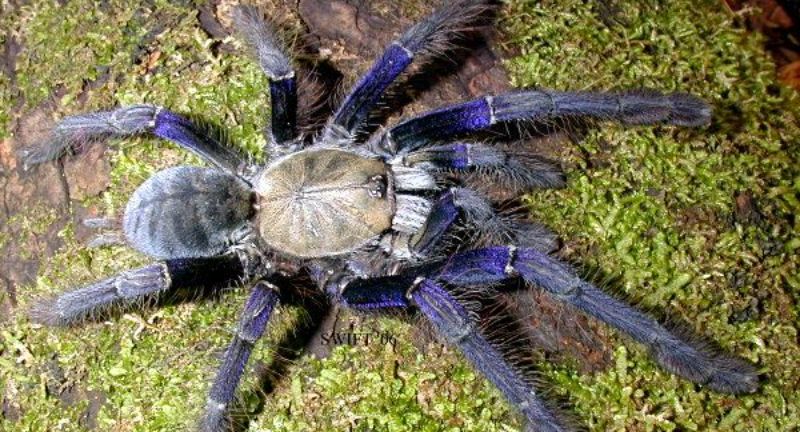
Shutterstock
The Singapore Blue tarantula stands out for its striking blue hue and significant size, boasting a leg span of up to 9 inches. This arboreal species calls the lush rainforests of Singapore and Malaysia home, preferring the lofty canopies for its habitat. Characterized by its bold temperament and swift movements, it presents a considerable challenge to novice tarantula keepers. Despite, or perhaps because of, its demanding care requirements, the Singapore Blue’s captivating appearance and intriguing behaviors have rendered it a prized specimen within the exotic pet trade, attracting enthusiasts eager to add this vibrant creature to their collections.
European Cave Spider
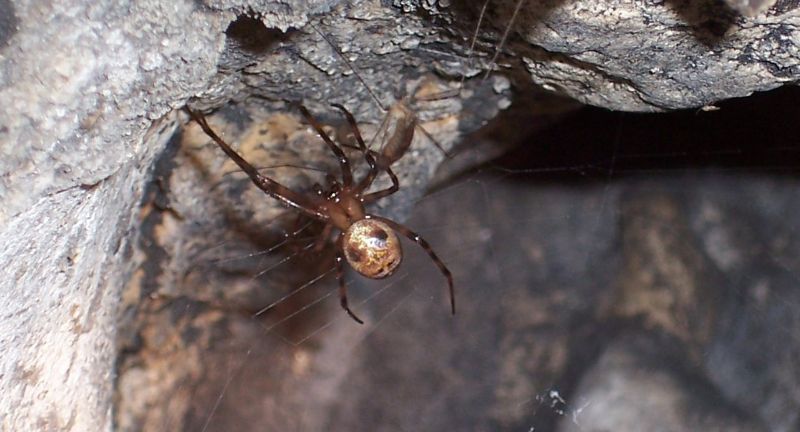
Shutterstock
The European Cave Spider, notable for its considerable leg span of up to 4 inches, thrives in the shadowy realms of caves and mines, where dampness prevails. This species is an adept architect, weaving expansive, complex orb webs to capture its prey, thus playing an essential role in regulating insect populations in these hidden ecosystems. Although it leads a concealed existence, the European Cave Spider significantly contributes to ecological equilibrium, showcasing the variety of life flourishing in darkness. Its presence highlights the importance of safeguarding even the most secluded natural habitats, ensuring the preservation of the delicate and diverse tapestry of life that dwells beneath the surface.
Brazilian Wandering Spider
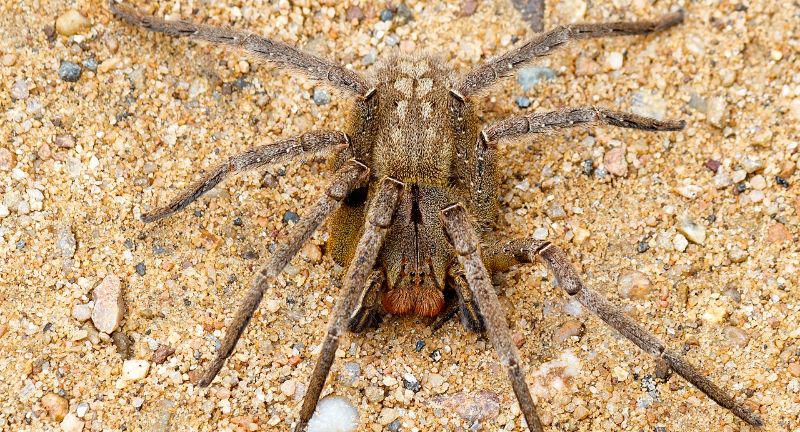
Shutterstock
The Brazilian Wandering Spider, infamous for its status as one of the most venomous spiders globally, can reach a leg span of up to 5 inches. These spiders exhibit high aggression levels and are characterized by their nocturnal “wandering” on the jungle floor in pursuit of prey, eschewing web construction. Their venom is laced with a potent neurotoxin, which has piqued the interest of medical and scientific communities. Despite their daunting reputation, human encounters with these spiders are comparatively uncommon. Their presence serves as a reminder of the complex interplay of fear, fascination, and the deep respect we owe to even the most perilous inhabitants of the natural world, underscoring the nuanced equilibrium that exists between humans and the myriad forms of life on Earth.
Greenbottle Blue Tarantula
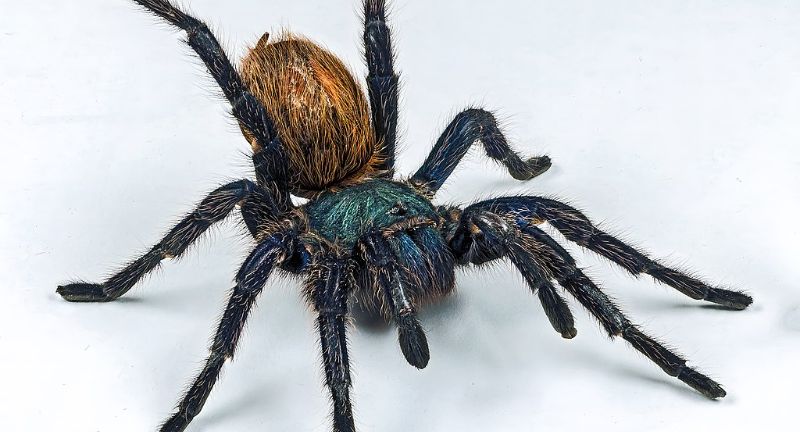
Wikipedia
The Greenbottle Blue Tarantula stands out for its remarkable blue legs and green carapace, earning it a spot as one of the most visually captivating spiders. Though its leg span of approximately 6 inches does not make it the largest, its vibrant colors place it among the most eye-catching. Originating from Venezuela, this species enjoys popularity in the pet trade, attributed to its striking looks and generally gentle demeanor. It excels as a web builder, crafting elaborate silk constructions that serve as effective traps for ensnaring prey.
Cerbalus Aravaensis
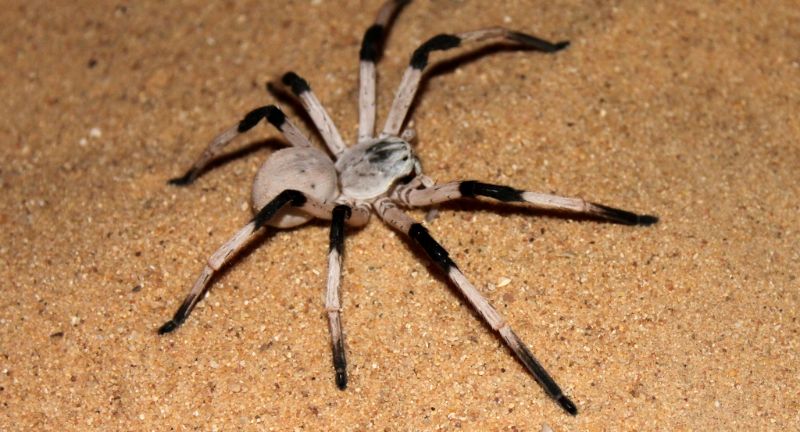
Wikipedia
Cerbalus Aravaensis is distinguished as the largest spider in the Middle East, showcasing a leg span that can extend to 5.5 inches. Thriving in the Arava Valley’s sand dunes, this nocturnal predator is well-suited to the rigorous demands of desert life. Its considerable size and robust physique enable it to hunt insects, small lizards, and fellow spiders effectively. With a sandy hue that blends seamlessly into the desert environment, it exemplifies stealth in predation, lying in wait for unsuspecting prey.
Poecilotheria Rajaei
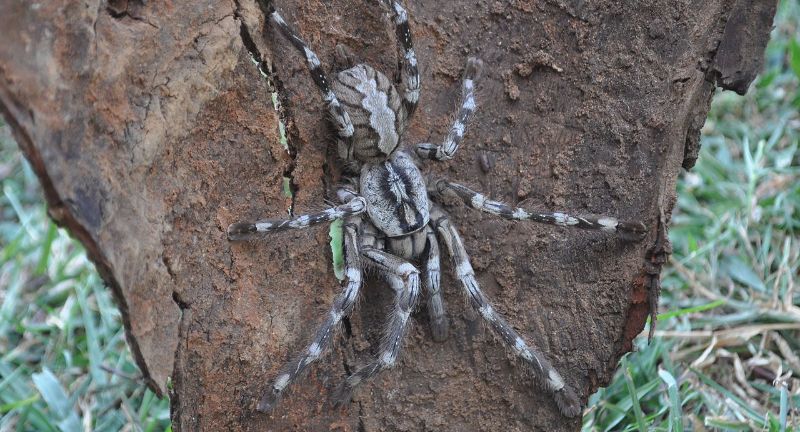
Wikipedia
Poecilotheria Rajaei, a notably large tarantula hailing from Sri Lanka, impresses with a leg span that reaches up to 8 inches. This member of the “tiger spider” family is celebrated for its unique patterns and vivid colors. It makes its home within ancient trees, placing its natural habitat at risk due to deforestation. Beyond its remarkable size, this spider stands as a testament to the wonders of nature, playing a crucial role in the biodiversity and ecological equilibrium of its surroundings.
King Baboon Spider
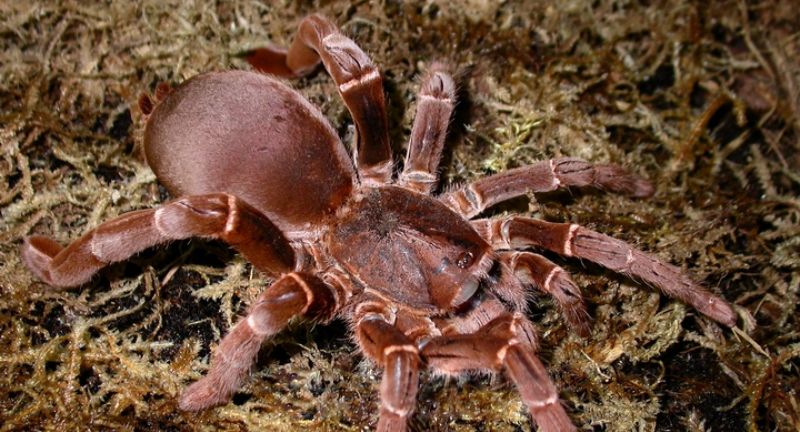
Wikipedia
The King Baboon Spider, originating from East Africa, can achieve a leg span of up to 8 inches. This species is distinguished by its densely hairy body and sizable, potent fangs, which are crucial for overpowering its prey. As a burrowing tarantula, it predominantly resides within the confines of its subterranean hideout. Known for its more aggressive nature compared to other tarantulas, it is less frequently chosen as a pet, reflecting its formidable demeanor and preference for solitude.
African Giant Black and White Tarantula
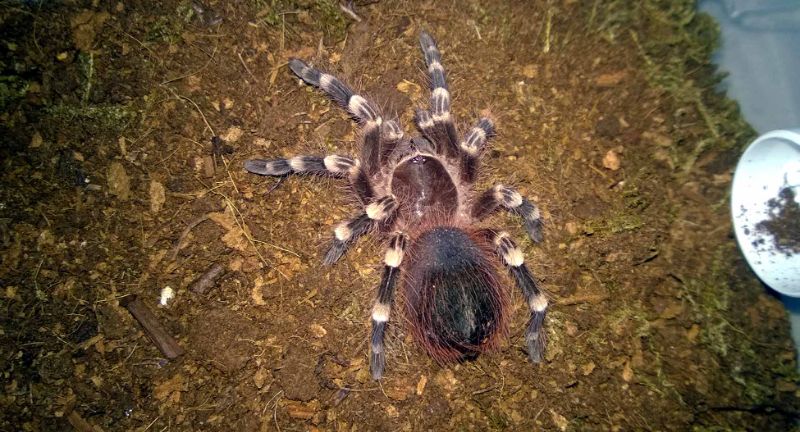
Pet Trade
The African Giant Black and White Tarantula, scientifically recognized as Citharischius crawshayi, can boast a leg span of approximately 7.5 inches. Its notable black and white patterning renders it among the most visually unique tarantulas. Originating from the forests of Central Africa, this tarantula engages in burrowing behavior, often remaining concealed underground. Its impressive size and distinctive look make it a coveted specimen among collectors and arachnid enthusiasts, although its tendency towards defensiveness necessitates cautious handling.
Texas Brown Tarantula
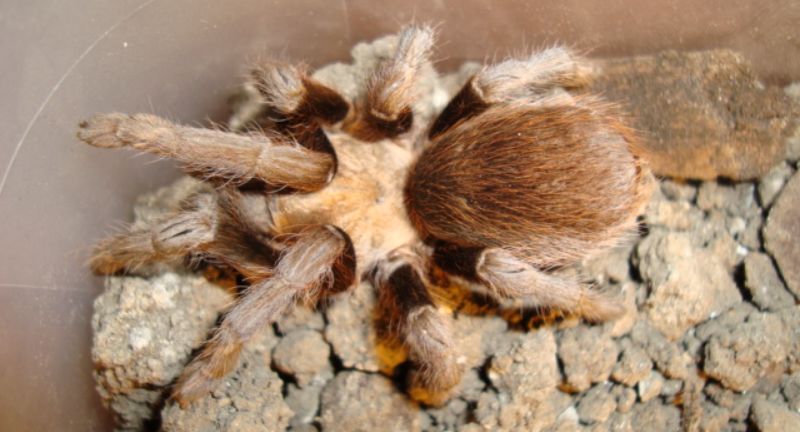
Shutterstock
The Texas Brown Tarantula, or Aphonopelma hentzi, is frequently encountered in the southern United States, standing as a prominent figure with a leg span extending to 6 inches. This positions it among the more sizable spider varieties native to North America. Preferring a terrestrial lifestyle, it typically inhabits open terrains, engaging in the hunt for small insects and arthropods. Its gentle demeanor has garnered favor among tarantula aficionados, earning it a reputation as a preferred pet for enthusiasts seeking to include a tarantula in their collection.
Ecuadorian Purple Tarantula
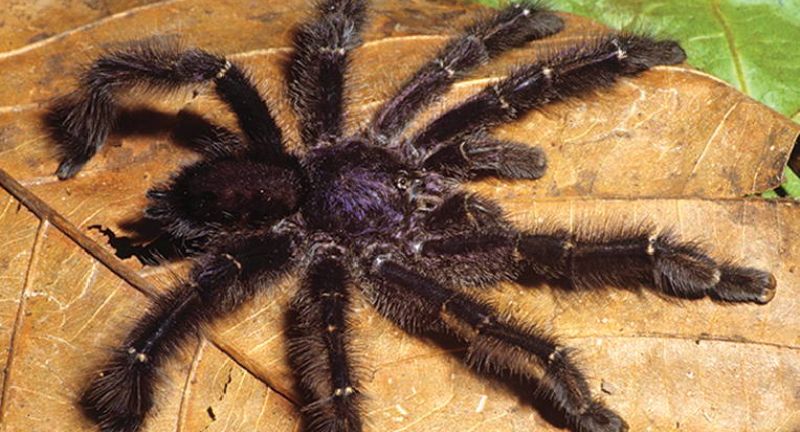
Wikipedia
The Ecuadorian Purple Tarantula captivates with its vivid purple coloration, setting it apart in the tarantula world. With a leg span that can extend up to 6 inches, this species calls the rainforests of Ecuador home. As an arboreal tarantula, it opts for a life amidst the treetops, crafting silk hideaways from which it can spring upon its prey. The combination of its striking appearance and tree-dwelling habits renders it a prized specimen among spider aficionados and collectors, eager to add such a remarkable creature to their collections.
Yellow Blue Tarantula
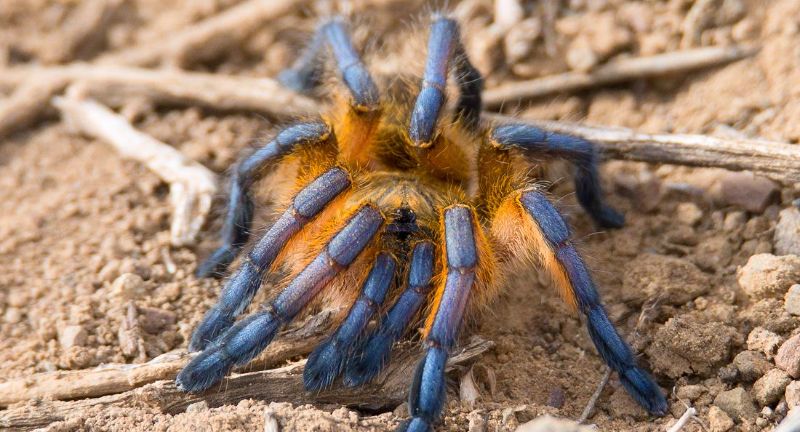
Wikipedia
The Yellow Blue Tarantula, distinguished by its distinctive color palette, can boast a leg span reaching up to 8 inches. This South American native dazzles with its vivid contrast between yellow and blue hues. It thrives in forest habitats, where it hunts insects and small creatures as its primary diet. This tarantula has become a coveted pet among enthusiasts who value its stunning appearance and possess the expertise to care for larger spider species.
Red Knee Tarantula
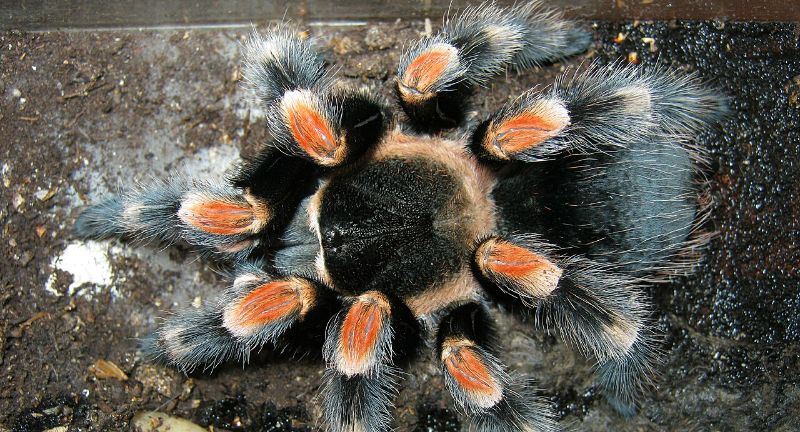
Wikipedia
The Red Knee Tarantula stands out for its striking red knees set against a darkly hued body, making it a visually iconic species within the tarantula community. It reaches a leg span of approximately 5.5 inches and is among the most recognizable and frequently photographed of tarantulas. Originating from Mexico, this species adopts a burrowing lifestyle, creating and inhabiting underground tunnels. Its gentle temperament combined with its eye-catching appearance has endeared it to tarantula enthusiasts globally, securing its status as a beloved pet choice.
Ornamental Tree Spider
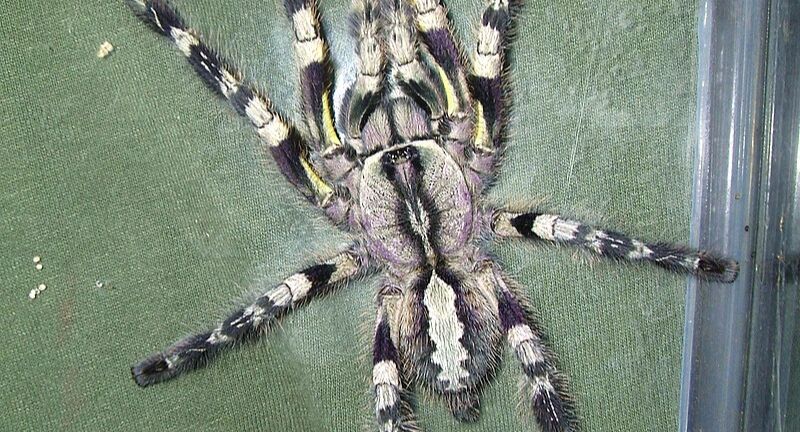
Wikipedia
The Ornamental Tree Spider, or Poecilotheria metallica, captures attention with its remarkable metallic blue hue. Sporting a leg span that can reach 7 inches, it hails from India. As an arboreal creature, it is highly valued within the pet trade, not only for its striking beauty but also for its scarcity. Preferring the seclusion of tree hollows, it crafts silk hideaways where it can remain concealed and poised to ambush unsuspecting prey, showcasing a blend of natural beauty and predatory skill that fascinates enthusiasts and collectors alike.
Australian Funnel-Web Spider
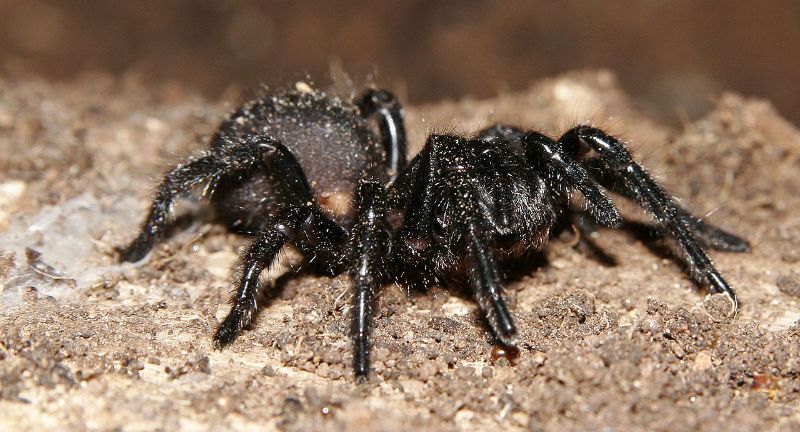
Shutterstock
The Australian Funnel-Web Spider holds a daunting reputation as one of the world’s most venomous spiders. This species can attain a size of up to 5 inches, characterized by a robust body and sizable fangs that can penetrate even through fingernails. Indigenous to Australia, it thrives in damp, cool settings, commonly inhabiting shaded gardens and wooded areas. Although its venom poses a significant threat, actual bite occurrences are infrequent, and an effective antivenom has been developed, mitigating the risk posed by this formidable arachnid.
Venezuelan Sun Tiger
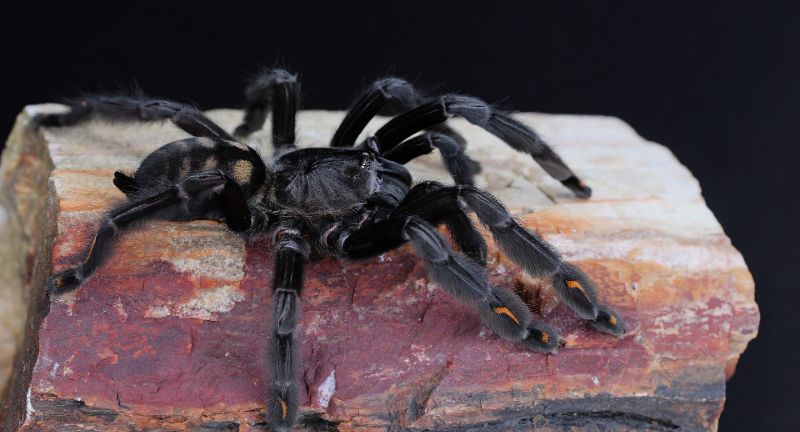
Shutterstock
The Venezuelan Sun Tiger tarantula, notable for its vivid orange and black patterning, is on the smaller side of tarantula species but no less striking. With a leg span that can extend to about 6 inches, it calls the forests of Venezuela its home. As an arboreal species, it resides in trees, weaving complex webs to ensnare its prey. The combination of its stunning appearance and proactive hunting tactics renders it an intriguing specimen for tarantula aficionados.
Brazilian Whiteknee Tarantula
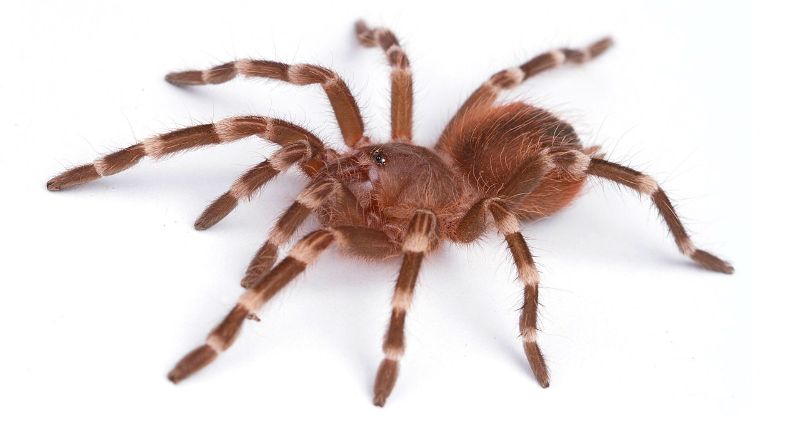
Shutterstock
The Brazilian Whiteknee Tarantula, distinguished by its striking black body adorned with white-striped legs, boasts a leg span that can span up to 8.5 inches. Originating from Brazil, this tarantula is celebrated for its bold pattern and considerable size. As a ground-dwelling species, it favors life within meticulously crafted burrows. Its popularity in the pet trade is largely due to its captivating appearance and generally mild temperament, making it a favored choice among enthusiasts seeking a visually impressive yet manageable tarantula.
Huntsman Spider
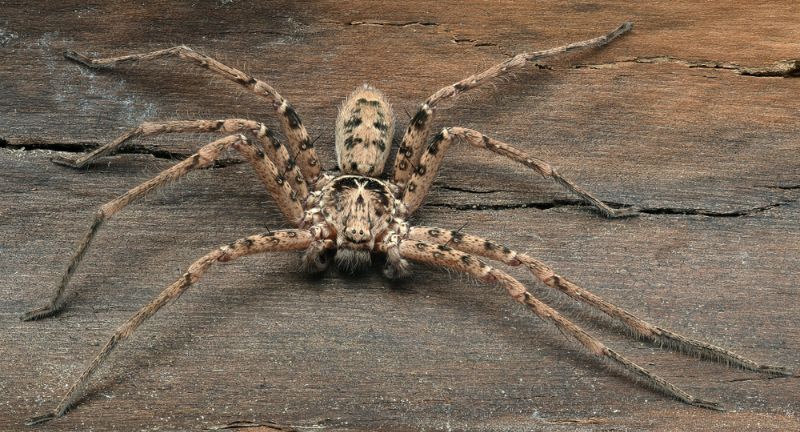
Shutterstock
Huntsman Spiders distinguish themselves with their notable size and remarkable speed. Their leg span can surpass 12 inches, placing them among the world’s largest spiders. Inhabiting warm climates from Australia to Asia and Africa, they thrive in natural crevices and engage in nocturnal hunting, eschewing web construction for a more direct approach to capturing prey.
Brazilian Salmon Pink Birdeater
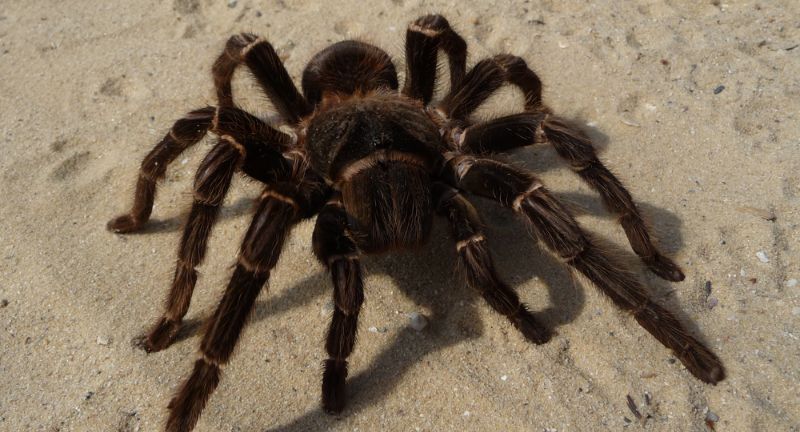
Shutterstock
The Brazilian Salmon Pink Birdeater captivates onlookers with its vivid hue and formidable size. With a leg span reaching up to 10 inches, it ranks among the largest tarantulas. This species, originating from Brazil, is characterized by its unique salmon-pink hairs. Despite its daunting presence, it is typically regarded as gentle and docile in its interactions with humans.
Feather-Legged Orb Weaver
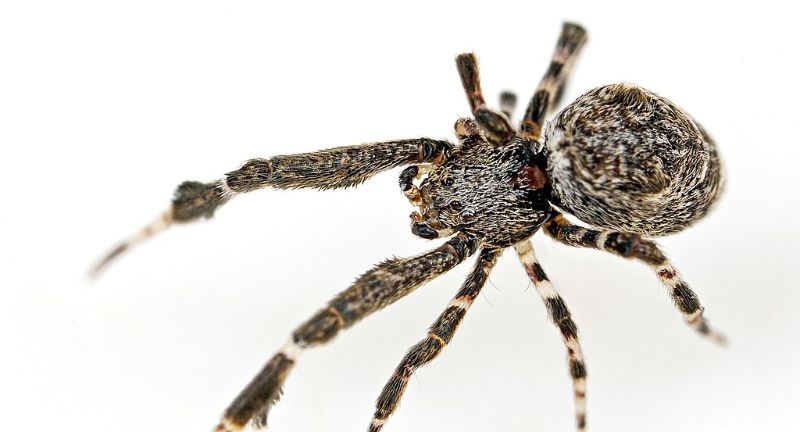
Shutterstock
The Feather-Legged Orb Weaver captivates with its distinctive look, featuring fine, feather-like details on its legs that set it apart from other spiders. Though it might not rank as the largest spider by body size, it compensates with the creation of expansive and complex webs designed for ensnaring prey. Distributed across diverse global habitats, this spider displays a variety of colors and patterns, adding to its allure. Its webs are not just functional but also aesthetic wonders, strategically placed to capture the morning dew or sunlight, resulting in a mesmerizing display that highlights the intricate beauty and engineering prowess of nature.
Chaco Golden Knee
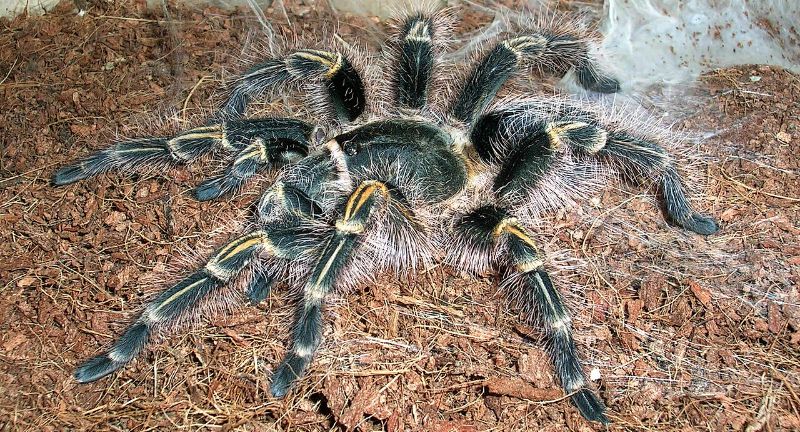
Shutterstock
The Chaco Golden Knee, recognizable by the striking golden stripes adorning its knees, is capable of achieving a leg span of up to 8 inches. Originating from the grasslands of Argentina and Paraguay, this tarantula exhibits a propensity for burrowing. Its gentle nature has endeared it to tarantula enthusiasts, making it a favored option for those maintaining arachnid collections. Notably, the Chaco Golden Knee is celebrated for its potential for longevity, with some specimens living up to 20 years in captivity, illustrating both the resilience and the enduring appeal of this species among keepers.
Golden Silk Orb-Weaver
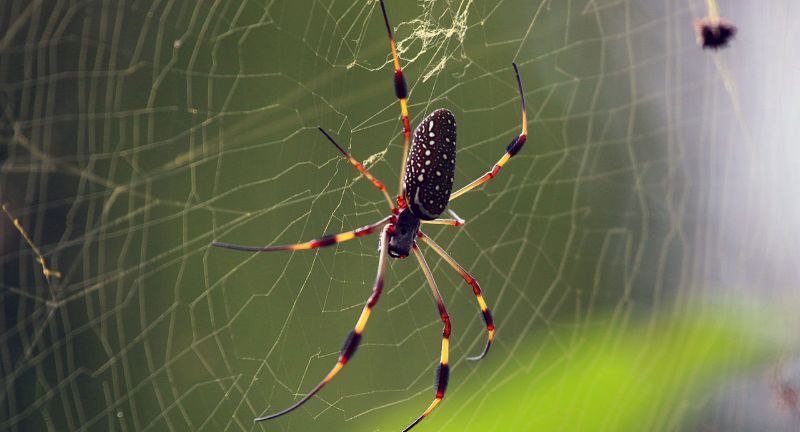
Shutterstock
The Golden Silk Orb-Weaver is celebrated for its extraordinary web, distinguished by a golden luster that catches the sunlight. This spider, capable of a leg span up to 5 inches, thrives in warm climates globally. The durability and aesthetic appeal of its silk have spurred biomimetic studies aiming to replicate its properties for materials science advancements. The spider’s proficiency in weaving such remarkable structures stands as a tribute to nature’s evolutionary ingenuity, highlighting the complex and elegant adaptations creatures have evolved for endurance and success.
Carolina Wolf Spider
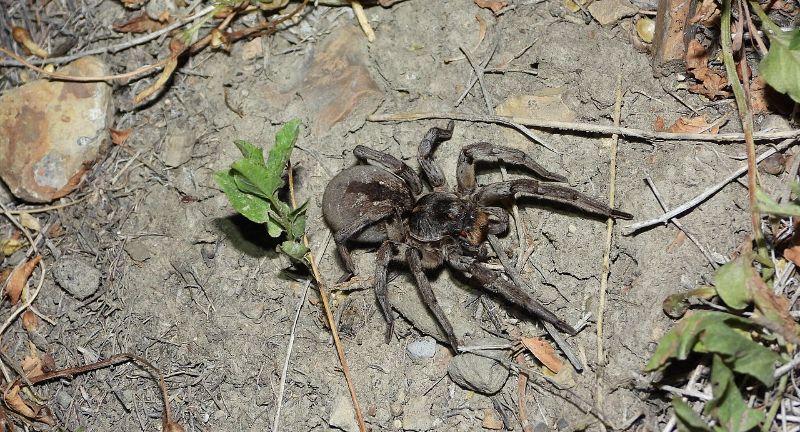
Shutterstock
The Carolina Wolf Spider holds the title of being the largest wolf spider across North America, boasting a leg span that can extend to 4 inches. Renowned for its ground hunting tactics, this spider is celebrated for its remarkable speed and agility, opting to pursue its prey directly instead of relying on webs. Equipped with superior night vision, it adeptly hunts in the dark, utilizing its keen senses to track down prey. The Carolina Wolf Spider exemplifies the vital ecological role spiders play as natural pest controllers, showcasing the wide range of functions spiders fulfill and emphasizing their crucial contribution to ecological equilibrium across diverse environments.
Conclusion

Shutterstock
In wrapping up our journey through the domain of the world’s most formidable spiders, we uncover a profound truth: their intrigue extends far beyond mere size. These arachnids are indispensable stewards of our ecosystems, acting as natural regulators of pest populations and vital links within the food web. Our expedition into the lives of these extraordinary spiders underscores the criticality of biodiversity and the urgent need to shield their environments from the ravages of deforestation and the impacts of climate change. A deeper understanding and respect for these remarkable creatures can dispel fears, cultivating a deeper appreciation for their essential role in maintaining ecological harmony. As we reflect on our discoveries, let’s carry forward the essential message of conservation and mutual existence that these spiders embody, reminding us of our interconnectedness with the vast tapestry of life that adorns our planet.
More Amazing Animals+
-
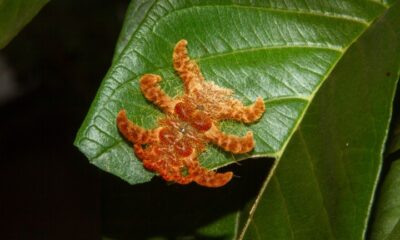

29 Caterpillars That Look More Like Fuzzy Aliens Than Animals
-


27 Most Intelligent Animals And How They Problem Solve
-


30 Most Interesting Mutualistic Relationships In Nature
-


27 Animals That Mate For Life
-
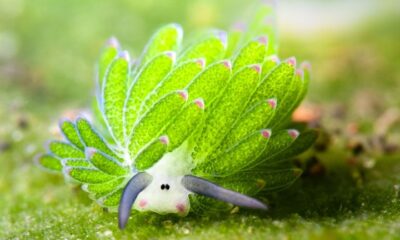

28 Most Colorful Critters From Around The World
-
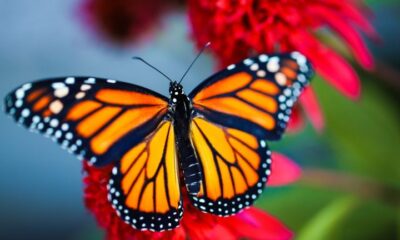

25 Facts About Monarch Butterflies And Their Remarkable Migration Journey
-


Wasps Are Not So Bad, Here’s Why
-
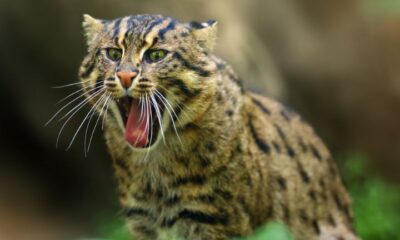

27 Animals With The Most Elaborate Hunting Strategies
-
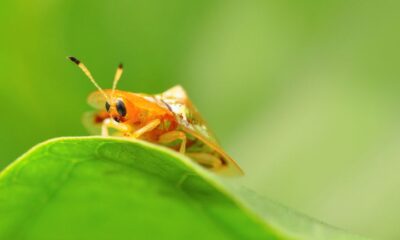

28 Animals That Use Camouflage For Protection
-
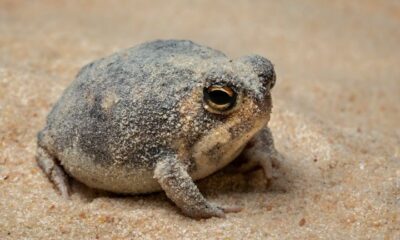

27 Animals That Live In The Most Extreme Conditions
-


Fatal Fangs: The 20 Most Dangerous Spiders in the World
-


25 Mythical And Misunderstood Animals
